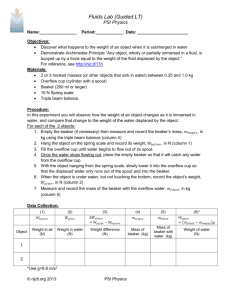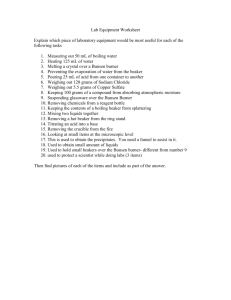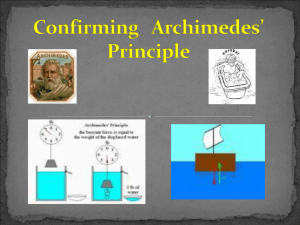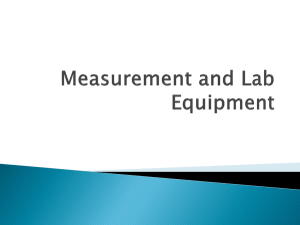A Novel Way to Measure Density - The L
advertisement
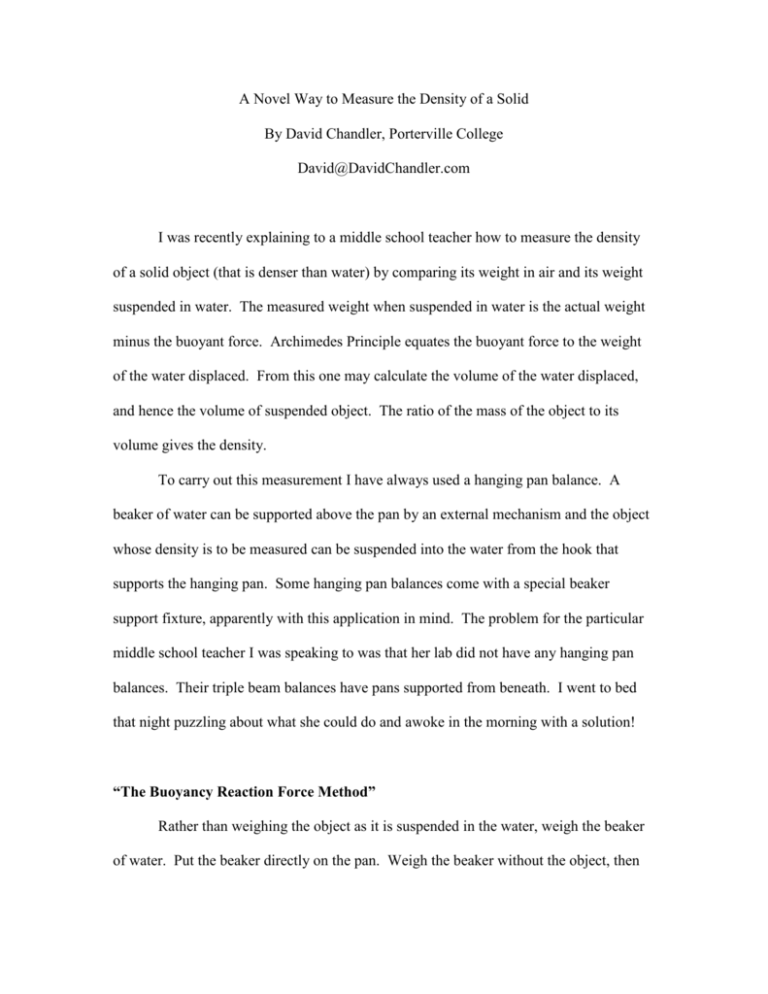
A Novel Way to Measure the Density of a Solid By David Chandler, Porterville College David@DavidChandler.com I was recently explaining to a middle school teacher how to measure the density of a solid object (that is denser than water) by comparing its weight in air and its weight suspended in water. The measured weight when suspended in water is the actual weight minus the buoyant force. Archimedes Principle equates the buoyant force to the weight of the water displaced. From this one may calculate the volume of the water displaced, and hence the volume of suspended object. The ratio of the mass of the object to its volume gives the density. To carry out this measurement I have always used a hanging pan balance. A beaker of water can be supported above the pan by an external mechanism and the object whose density is to be measured can be suspended into the water from the hook that supports the hanging pan. Some hanging pan balances come with a special beaker support fixture, apparently with this application in mind. The problem for the particular middle school teacher I was speaking to was that her lab did not have any hanging pan balances. Their triple beam balances have pans supported from beneath. I went to bed that night puzzling about what she could do and awoke in the morning with a solution! “The Buoyancy Reaction Force Method” Rather than weighing the object as it is suspended in the water, weigh the beaker of water. Put the beaker directly on the pan. Weigh the beaker without the object, then again with the object dangling in the water, but not resting on the bottom. The object can be suspended from a lab stand or even by hand! Since the water supplies an upward buoyant force on the suspended object, Newton's Third Law says the object will produce an equal downward force on the water. The excess weight of the water thus equals the buoyant force, which equals the weight of the displaced water, from which the volume of displaced water may be found. Computation for the illustrated example: The electronic scale shown in the illustrations measures only to the nearest gram, so the numbers obtained here are very crude, but still illustrative. The mass of the ball in air is 70 grams. The mass of the beaker of water without the ball is 156 grams. The scale reading with the ball suspended in the water (but not touching the beaker) is 165 grams. Note that the scale, even though it is calibrated in units of mass, is actually responding to force (weight). The extra 9-gram reading is the reaction force to the upward buoyant force on the ball. According to Archimedes’ Principle the buoyant force is equal to the weight of the water displaced. From the gram-calibrated scale readings we can conclude we have displaced 9 grams of water. Since the density of water is 1 gram/cm3, the ball must occupy 9 cm3. Dividing the mass of the ball by the volume of the ball, the density is computed to be 7.77 gram/cm3 (playing fast and loose with significant digits). Conclusions The “buoyancy reaction force” method is more versatile than the traditional approach. Any kind of scale can be used, including the new generation of milligram electronic pan balances frequently found in chemistry labs. Milligram precision translates to 0.001 cm3 (0.001 ml) precision for the volume measurement. Direct water displacement in a graduated cylinder could not even approach this precision. On the other extreme the revised method would allow you to tie a string around a large chunk of rock and suspend it in a bucket of water on a bathroom scale. This is something students could do at home. On another level, the discussion of buoyancy and its third-law reaction force on the water opens an unexpected teaching opportunity: reason enough to introduce this method to students. Watching the weight of the beaker of water change as the object is lowered into it is a wonderful direct confirmation of something that is not at all intuitive for most students. The implications of the method are perhaps even more interesting and instructive than the original lesson on density. Captions: (Reduced-size images are shown here to identify them. Full-size image files are attached to the emailed manuscript.) Fig. 1 Ball weighed in air: 70 grams Fig. 2 Mass of beaker of water: 156 grams Fig. 3 “Mass” reading for beaker with ball suspended in it. Note that this is really a weight reading calibrated in grams. Nothing in the picture has a mass of 165 grams. The scale measures the weight of the beaker plus the reaction to the buoyant force converted to gram units. By Archimedes’ Principle the 9-gram difference between this and the previous reading is the mass of the displaced water.

